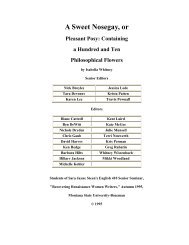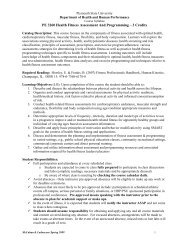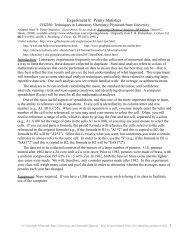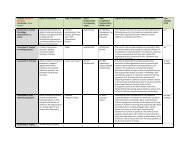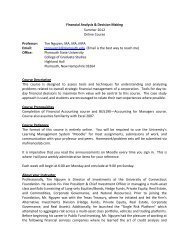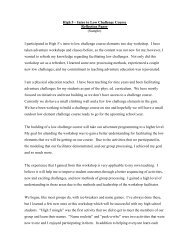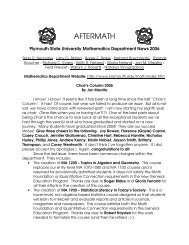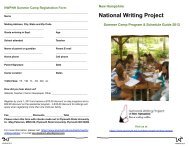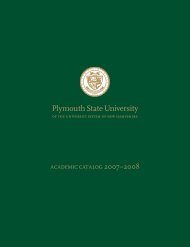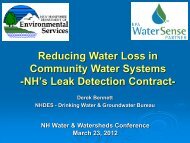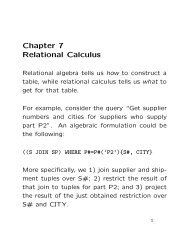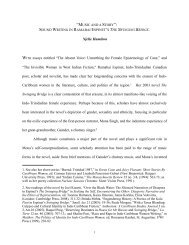View Syllabus - Plymouth State University
View Syllabus - Plymouth State University
View Syllabus - Plymouth State University
- No tags were found...
You also want an ePaper? Increase the reach of your titles
YUMPU automatically turns print PDFs into web optimized ePapers that Google loves.
Course DescriptionTo provide literacy instructors with practical suggestions, approaches, and toolsto engage all K-12 students, including adolescents themselves, in focusing onimproving student reading, writing, thinking, and listening. A three tiered modelwill examine the areas of student motivation, integrating literacy and learning,and sustaining literacy development. The final product will be the formation of sixdifferentiated instructional plans in the content area demonstrating the use ofstrategies presented in the course. These plans/ vignettes will be in variouscontent areas, grade levels, and formats.A district wide presentation can be developed from the culmination of allstudents’ artifacts.ADA <strong>State</strong>ment<strong>Plymouth</strong> <strong>State</strong> <strong>University</strong> is committed to providing students with documenteddisabilities equal access to all university programs and facilities. If you think you have adisability requiringaccommodations, you must register with the PASS office in Lamson Library (535-2270).If you have a Letter of Academic Accommodation for this course from the PASS office,please provide the instructor with that information privately so that the accommodationscan be reviewed.Diversity Framework for Teacher Education(1) Critically examine her or his own identity, and accept that our background and experiencesshape our view of the world(2) Learn from and about students, families and communities(3) Identify and empathize with and accept students from diverse backgrounds(4) Become a multicultural person by exploring and learning to understand the experiences andvalues of others(5) Confront racism and other biases in her/himself, her/his classroom. And in schools and otherinstitutions in society(6) Demonstrate commitment and skills to act as a change agent(7) Implement culturally responsive teaching practicesCHECK-Conceptional Framework for Teacher EducationNCATE Knowledge Base/Competencies emphasized in this Course: (CHECK)C=Collaborative, Consultative, Supervisory Skills, and Public RelationsH,K = Effective Teaching of the Language Arts, K-12E = Literacy Program Philosophy, Operation, Management, Budget and EvaluationC = Literacy Specialist as Researcher, Leader, and Change AgentCommitment We define commitment as dedication, perseverance, and individual and socialresponsibility. Our candidates are committed to lifelong learning and to increasing selfknowledge.They are committed to the beliefs that all students can learn and that education has
the power to transform individuals and the greater society. Our teacher candidates recognize theresponsibility of educators to take a thoughtful and critical stance towards themselves and theirprofession.Holism Our holism perspective involves affirming diversity and understanding the “wholechild” within the family, community and cultural context. It includes working towards an integratedcurriculum and recognizing how we as educators are shaped by our own experiences andculture. This holistic perspective shapes our larger vision.Experience Experience allows us to put theory into practice. We provide opportunities forexperiential learning that serves communities and schools so that our teacher candidates can dothe same for their students. Experience also involves constantly renewing skills and knowledgewithin one’s discipline.Collaboration Collaboration involves working with students, families and colleagues effectivelywithin the school context toward shared goals, demonstrating respect and opennesstowards diverse perspectives, and confronting and resolving conflicts effectively and respectfully.Collaboration enhances both teaching and learning, and is an essential part of developing thecapacity to lead.Knowledge Knowledge refers to understanding the theory, content, methods, and materialsand technologies of one’s field, as well as understanding child and adolescent development,learning processes, and student motivation within the familial, community, and culturalcontexts in which children grow and learn. Teaching that engages all learners combines aknowledge of students and one’s subjects within the cultural, social and institutional context.PERFORMANCE OBJECTIVES/ Students will:1. Learn what motivates and engages the adolescent learner, as well as, allother learners.2. Learn and model strategies to deepen the understanding of content material3. Create and present a technological differentiated instructional plan for aspecific content area4. Examine and discuss current research on content literacy and the impact ithas on the male adolescent learner5. Incorporate adolescent literature into content literacy lessonsAssignment Descriptions:Differentiated Instructional Plano Construct 6 typed narrative lessons ( vignette style ) withtechnology aidso Lessons are for a variety of content subject areas and gradelevelso Present the plan overviewo Lessons and technology submitted for gradingo Lessons should include the following:(a) Grade level/ Content Area/ Unit Topic:
(b) Learning Standards/ Instructional Goals (Content- Whatspecific content or concepts do you want students to understand and beable to apply as a result of instruction result of instruction you willprovide?):(c) Literacy Habits and Skills ( Literary Outcomes – How willstudents be expected to read, write, discuss, present, and engage incritical and creative thinking in relation to content?):(d) Meeting Learning Needs strategy and differentiation( Motivation and Engagement- How will you include structured orsupported choice, use of technology, collaborative learning, andauthentic reasons to read and write as partof this content?):o Comprehension elements for the Differentiated Plan1. Comprehension Process- making connections to priorknowledge, generating questions, creating mental images,making inferences, determining importance, synthesizing2. Instructional Focus- frontloading, guiding comprehension,consolidating understanding3. Strategies that frame instruction – problem/solution,cause/effect, compare/contrast, proposition/support,goal/action/support, concept/ definition4. Comprehension Process- making connections to priorknowledge, generating questions, creating mental images,making inferences, determining importance, synthesizing5. Instructional Focus- frontloading, guiding comprehension,consolidating understanding6. Strategies that frame instruction – problem/solution,cause/effect, compare/contrast, proposition/support,goal/action/support, concept/ definition7. Comprehension Process- making connections to priorknowledge, generating questions, creating mental images,making inferences, determining importance, synthesizing8. Instructional Focus- frontloading, guiding comprehension,consolidating understanding9. Strategies that frame instruction – problem/solution,cause/effect, compare/contrast, proposition/support,goal/action/support, concept/ definition
Assignment Evaluation:Reflective Responses to Readings and Class Participation 25%Class Study/LEEP w/ Supporting Resource List 50%Portfolio w/ Reflection 25%TOTAL 100%A, A- 90–100% B+, B, B- 80-89% IncompletesSession #1Course overview and project in detailo Define Content Literacy (K-12)o Examine the problemo Each session students will share specific strategies based on assignedelements.o Comprehension Process- making connections to prior knowledge,generating questions, creating mental images, making inferences,determining importance, synthesizingSession#2o Instructional Focus- frontloading, guiding comprehension, consolidatingunderstandingo Strategies that frame instruction – problem/solution, cause/effect,compare/contrast, proposition/support, goal/action/support, concept/definitionSession #3o Sharing/explanation/modeling of strategies that can be used forvocabulary and comprehension.o Student Motivation, engagement and achievemento Discussion of vignette/lesson plano Work with partners to begin formulating the final projectSession #4o Comprehension Process- making connections to prior knowledge,generating questions, creating mental images, making inferences,determining importance, synthesizingo Instructional Focus- frontloading, guiding comprehension, consolidatingunderstanding
o Strategies that frame instruction – problem/solution, cause/effect,compare/contrast, proposition/support, goal/action/support, concept/definitionSession #5o Sharing/explanation/modeling of strategies that can be used for notetakingo Sharing and feedback for one vignette/lesson plan that is in rough draftform.o Focus on the Learnero Ways to solve the problemo Integrating literacy and learningo Comprehension Process- making connections to prior knowledge,generating questions, creating mental images, making inferences,determining importance, synthesizingo Instructional Focus- frontloading, guiding comprehension, consolidatingunderstandingo Strategies that frame instruction – problem/solution, cause/effect,compare/contrast, proposition/support, goal/action/support, concept/definitionSession #6Classroom Strategies for Interactive Learning (pgs1-40)o Sharing/explanation/modeling of strategies that can be used for textstructureo Construct Meaning from Texto Classroom Strategies by Comprehension Process, Instructional Focus,and Content Area (K-12)o Comprehension elements for the Differentiated Plano Comprehension Process- making connections to prior knowledge,generating questions, creating mental images, making inferences,determining importance, synthesizingo Instructional Focus- frontloading, guiding comprehension, consolidatingunderstandingo Strategies that frame instruction – problem/solution, cause/effect,compare/contrast, proposition/support, goal/action/support, concept/definition
Session #7o Differentiating the instruction (content specific) as well as Ell and diversesituationso Sharing/explanation/modeling of strategies that can be used for writingand summarizingo Appendix *B – pages 172- 177 Vignettes – ProjectsSession # 8o Sharing/explanation/modeling of strategies that can be used for researchand test takingo Contribution to Solving the problem(a) Identified the learner(b) Focused on learner’s styles(c) Identified the instructors concerns – also deal with resistantteachers(d) Provided concrete models(e) Create a planSession #9o Power Point slides on USB flash drive or personal computero Students should bring a flash drive if they wish to download otherpresentations or if class decides that posting on BB is besto Vignettes/ lesson plans will be hard copies accompanied by the strategylessons- typed




